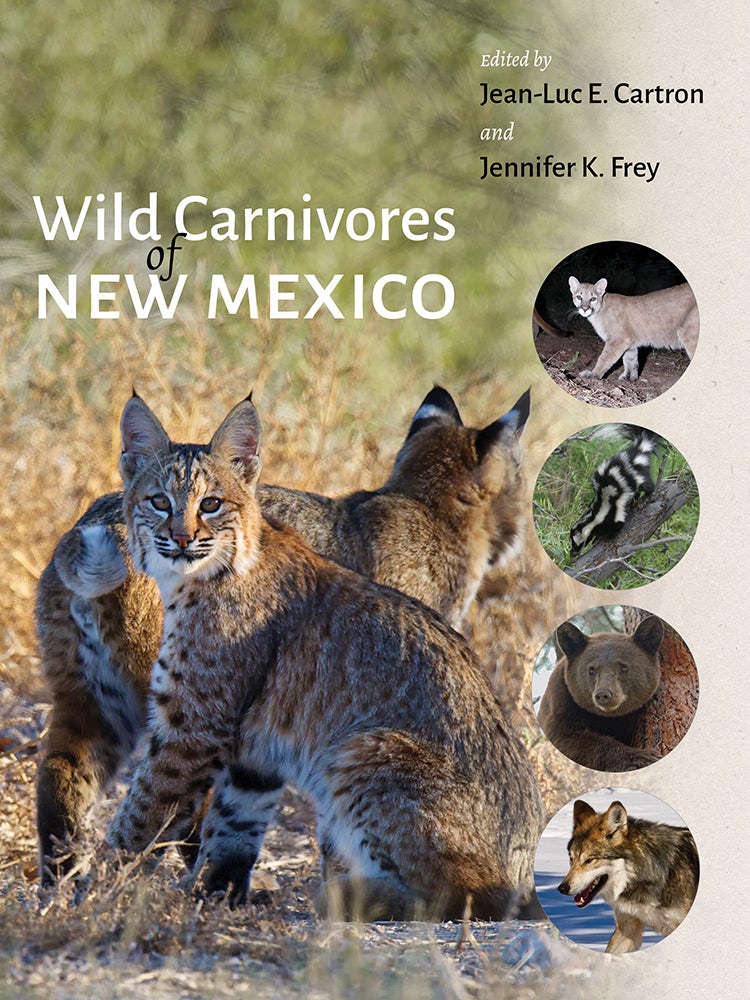A new book from a University of New Mexico researcher examines the wild carnivores of New Mexico, from the common striped skunk to the now extinct grizzly bear. Jean-Luc E. Cartron, a research professor in the UNM Department of Biology, teamed up with Jennifer K. Frey, professor of mammalian ecology in the Department of Fish, Wildlife, and Conservation Ecology at New Mexico State University, to write and edit Wild Carnivores of New Mexico.

The 1,148-page book published earlier this year by the University of New Mexico Press is a landmark study of all the species belonging to the order Carnivora such as black bear, mountain lion, gray wolf, coati, foxes, and skunks in New Mexico. It explores major issues that shape their continued presence in the state and region, with discussions of their distribution, population status, habitat associations, life history, management, and conservation.
Cartron has already written or edited two books that were quite successful, including the Raptors of New Mexico, published by UNM Press in 2010. "Right after Raptors of New Mexico came out, I had the idea of a companion book that would focus on carnivores instead."
Cartron recalled the incident that inspired the book.
"In Wild Carnivores of New Mexico, there is an account of one of my early encounters with mountain lions—referred to as cougars throughout the book. The night I saw four mountain lions right in front of me was a magical moment I'll never forget. And I think perhaps it planted the seed of writing a book on carnivores in my mind."
"Most people are familiar with the striped skunk, which is the most common skunk species in New Mexico. Any skunk you might have seen at night in the Albuquerque area crossing the street and entering a storm drain is almost for sure a striped skunk. We also have the white-backed hog-nosed and hooded skunks."
The issues of hunting, trapping, and predator management are all covered in the book, as are climate change impacts, the border wall, and much more.
"Carnivores not only have large home ranges but they—particularly the males—also disperse to new areas when they are young adults or conditions become unfavorable where they live. All those movements can take place over large distances. The border wall negatively impacts those movements. This has been shown in the gray wolf, which has been reintroduced in the Southwest. Animals that are negatively affected or will be in the future also include the jaguar."
The red fox, which is often presented as a non-native species, is revealed to be a native carnivore, the North American red fox, worthy of research and conservation efforts.
"The red fox refers to the species found in Europe. And until recently, it was widely believed that the red fox found in North America, including in New Mexico, was introduced from Europe for hunting. Because it was thought to be non-native in North America, it had to be controlled as perhaps it artificially affected other species and whole ecosystems. Not only are North American red foxes native, their montane populations—representing their own evolutionary lineage—may be threatened. More research is needed, and North American red foxes need to be protected, not controlled as nuisance animals."
More skunk species exist in the state than previously believed.

"Most people are familiar with the striped skunk, which is the most common skunk species in New Mexico. Any skunk you might have seen at night in the Albuquerque area crossing the street and entering a storm drain is almost for sure a striped skunk. We also have the white-backed hog-nosed and hooded skunks. And recent research shows that New Mexico's western spotted skunks correspond to at least two species."
There is also a chapter on the extinction of the grizzly bear, another one on the carnivores of New Mexico during the Pleistocene.
Anyone with an interest in nature would enjoy the book, Cartron said, though some of the more technical discussions are geared more toward researchers and wildlife managers. The volume includes more than 700 color images and dozens of maps, figures, and tables to help readers visualize unique morphological or life-history traits, habitat, research techniques, and management and conservation issues.
"Some people will read every chapter from start to finish, but photos and maps serve as potential entry points for accessing information on any topic… We should recognize how lucky we are in New Mexico to have so much nature around us. All of us need to remain connected with that nature."
Wild Carnivores of New Mexico is an edited volume. Many of the leading experts on carnivore ecology, management, and conservation contributed to the book, which took more than 12 years to complete. Contributors from UNM include:
- Professor of Biology Joseph A. Cook, Department of Biology; Curator of Mammals, Museum of Southwestern Biology
- Jonathan L. Dunnum, Senior Collections Manager, Division of Mammals, Museum of Southwestern Biology
- Professor Emeritus Timothy K. Lowrey, Department of Biology and Museum of Southwestern Biology
- Professor Emeritus David S. Gutzler, Department of Earth & Planetary Sciences
Cartron is a graduate of UNM. He is the author or editor of several other books including the Field Guide to the Plants and Animals of the Middle Rio Grande Bosque (2008) and the award-winning Raptors of New Mexico (2010). His current research includes climate change impacts on the habitat of birds and mammals in the Southwest and PFAS contamination levels and exposure pathways in wildlife.
Wild Carnivores of New Mexico is available at the UNM and other local bookstores or directly from the University of New Mexico Press. To order, call 800-848-6224 or visit UNM Press online.
Top image: Striped skunk in Doña Ana County, New Mexico






